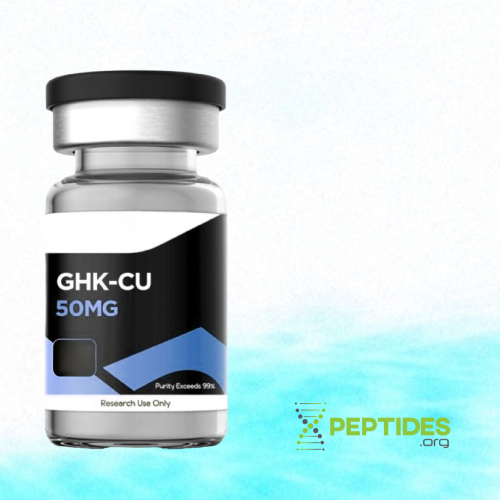Buy GHK-Cu Online | The A-Z Guide

Researchers curious about where to buy GHK-Cu online have plenty of options, but which peptide vendor is the best?
In this guide, we reveal our preferred vendor of GHK-Cu, a peptide known for its anti-aging and wound healing properties. To further assist researchers, we also outline the peptide’s documented benefits and safety profile, before providing a sample dosage protocol and answering a few frequently asked questions.
Availability: In-Stock
Price: $99.99
- FREE Shipping for orders over $200 (USA Only)
- $9.25 Flat Rate Shipping, USA Orders
- Includes one 30mL Bacteriostatic Water with orders over $200

What is GHK-Cu?
Copper peptide GHK-Cu is a short chain of amino acids that naturally occurs in the body, found in saliva, urine, and cell plasma. GHK-Cu was initially formulated in the 1970s, when a team led by Dr. Loren Pickart noted the regenerative properties of liver samples in young test subjects and proposed that this action was attributable to a peptide factor analogous to the synthetic tripeptide glycyl-histidyl-lysine [1].
GHK-Cu administration has since been shown to produce numerous regenerative and protective effects, including its ability to activate tissue remodeling, reverse age-related skin thinning and signs of aging, and repair skin barrier proteins [2, 3].
It is known that endogenous levels of GHK peptide naturally decline with age, from roughly 200 ng/ml at age 20 to 80 ng/ml at age 60 [3], and studies have shown that GHK-Cu can reset gene expression of human cells to a healthier state, which has led to breakthroughs in tissue regeneration and wound healing [4, 5, 6].

GHK-Cu Benefits | Clinical Trials
As the researcher credited with discovering GHK-Cu, Dr. Pickart has co-authored numerous research papers on GHK-Cu benefits, including its demonstrated abilities to restore proper gene functioning, induce skin regeneration, and stimulate wound healing [7, 8, 9]. We summarize the findings from GHK-Cu studies and clinical trials below.
Wound healing
A number of animal studies and clinical trials have shown that GHK-Cu facilitates skin repair and wound healing. By elevating levels of antioxidant enzymes and speeding up tissue growth, GHK-Cu has a direct impact on skin repair in both animal models and humans [5, 9, 10]. In one study involving diabetes patients with neuropathic ulcers, GHK-Cu gel significantly improved the rate of ulcer healing and reduced the incidence of infection [11].
Anti-aging
There is strong research interest in GHK-Cu as an anti-aging peptide due to its pronounced effect on skin firmness and elasticity [12]. Numerous controlled experiments have investigated topical formulations of GHK-Cu and reported positive effects. For example, a 12-week study involving 67 women found that GHK-Cu cream reduced wrinkles and increased skin thickness [8]. Another study involving female subjects found that copper peptide was more effective than vitamin C and retinoic acid in increasing collagen and reducing fine lines and wrinkles in the skin [13].
Although GHK-Cu peptide is commonly sold as an injectable solution for research purposes, the compound is included in a variety of topical skincare formulations, which are marketed as anti-aging products and available to the general public.
Tissue remodeling
GHK-Cu plays a strong role in remodeling tissue and helps repair damaged tissue by increasing protein synthesis of collagen. According to Dr. Pickart, GHK-Cu has been shown to activate a “plethora of remodeling-related processes” including [9]:
- Chemoattraction of repair cells (capillary cells, mast cells, macrophages)
- Suppression of free radicals
- Release of oxidizing iron
- Increased protein synthesis of collagen, elastin, anti-proteases, fibroblast growth factor, and metalloproteinases.
- Increased proliferation of fibroblasts and keratinocytes
Anti-tumor and anti-cancer action
According to Dr. Pickart, GHK-Cu peptide appears to offer both anti-tumor and anti-cancer action [5]. A 2010 study involving metastasis-prone patients found the GHK could “significantly reverse the differential expression” of 54 genes associated with colon cancer [14]. Dr. Pickart noted that GHK’s ability to change the pattern of gene expression helped “support the idea that GHK may help slow or suppress cancer growth.”
A 2017 paper by Pickart et al. noted that “GHK has been recommended as a treatment for metastatic cancer,” among other ailments, based on studies using the Broad Institute Connectivity Map, which demonstrated that GHK peptide modules expression of multiple genes [15].
Nerve regeneration
A 2005 study has indicated that GHK-Cu may help with nerve regeneration. The study linked GHK-Cu to nerve regeneration and showed that it increased the proliferation of Schwann cells in damaged tissue [6]. This is significant as Schwann cells are the major glial cell type in the peripheral nervous system and play essential roles in nerve function, development, maintenance, and regeneration.
GHK-Cu Side Effects
GHK-Cu has not been linked to any major side effects, with Dr. Pickart and co-authors having observed that the peptide “is very safe and no issues have ever arisen during its use as a skin cosmetic or in human wound healing studies” [5].
GHK-Cu’s lack of side effects has been cited by multiple researchers [3, 8, 9], and it has consistently been found to be non-toxic and a non-irritant [16].
Is GHK-Cu Safe?
Research studies and clinical trials have shown that GHK-Cu has a favorable safety profile and does not cause adverse events in test subjects. There is no clinical evidence linking GHK-Cu to any serious safety issues.
However, researchers undertaking long-term GHK-Cu studies or testing high-amount dosage protocols are advised to monitor subjects’ total copper levels. Researchers may consider adding zinc supplementation to maintain a balanced copper to zinc ratio in the subject.

GHK-Cu Dosage Calculator
Where available as an injectable reference material, GHK-Cu is not sold with an official or recommended dosage. Researchers typically establish GHK-Cu dosage protocols in accordance with a variety of factors, including the research objective and the research subject’s body weight.
Dr. Pickart and team have indicated that a treatment course of “100–200 mgs of GHK will produce therapeutic actions in humans” for wound healing applications, but that even this amount may be overstated [5]. At present, the prevailing GHK-Cu dosage protocol appears to be as follows:
- Daily Dosage: 1-2 mg of GHK-Cu.
- Frequency: Administer one subcutaneous injection daily for length of cycle.
- Cycle Duration: 25-30 days.
- Repeat Cycle: Each GHK-Cu course should be followed by a pause of at least one month.
- Notes: Monitor subject’s total copper levels and add zinc supplementation as necessary. One 50mg GHK-Cu vial suffices for one to two cycles.
It is worth noting that the lethal GHk-Cu dose has been estimated at 300 mg/kg, or about 21,000 mg for a 70 kg subject [15].
When administering a GHK-Cu topical product to a target area, apply either as directed by the manufacturer or in accordance with relevant guidelines.
Where to Buy GHK-Cu Online? | 2024 Edition
Researchers looking to procure GHK-Cu for their studies are probably aware that a number of unscrupulous online vendors ship substandard peptides.
It is thus crucial to carefully evaluate a vendor before making a purchase. Some things to look for include:
- Information about how the products are made
- Third-party laboratory test results
- Fair prices (not too low, not too high)
- Payment methods accepted
- Shipping policies
Over the years, our team has made test purchases from a number of peptide vendors, evaluating them based on the above criteria and more.
Based on our experience, we have identified the following top supplier of both injectable and topical GHK-Cu:
Limitless Life
For researchers wondering where to source high quality research peptides, look no further than Limitless Life.
Peptides.org highly recommends this company because of their stringent quality control practices, their fast and reliable shipping, their straightforward reship/return policy, and their commitment to safety.
Here’s more about why we prefer Limitless Life for research peptide sourcing:
- Strict Product Quality Standards: Limitless Life partners with third-party laboratories, which conduct stringent tests to assess quality, purity, and potency of every batch of peptides.
- Two-Day Domestic Shipping: Limitless Life offers two-day shipping on all domestic orders via FedEx. They also ship out most orders on the same day or within 48 hours of the order being placed.
- Simple Reship and Return Process: Limitless Life ensures satisfaction by offering an easy-to-use reship and/or return process and incredibly inexpensive shipping insurance.
- Safety Commitment: Limitless Life understands and goes to great lengths to emphasize that their peptide products are made available only to qualified researchers.
Limitless Life also is one of the few vendors who offers GHK-Cu capsules for research.
Lastly, for 10% off of an order at Limitless Life, peptide researchers can follow the link below and then use our exclusive code:
peptidesorg10
Buy GHK-Cu from our top-rated vendor...

FAQ
How to Reconstitute GHK-Cu
GHK-Cu needs to be reconstituted with bacteriostatic or sterile water prior to administration. To do so, extract the correct amount of water from the bacteriostatic or sterile water vial, and insert the water into the GHK-Cu vial. Then, gently swirl the solution until the peptide is dissolved and ready for administration.
GHK-Cu topical products do not need to be reconstituted.
How is GHK-Cu Delivered?
GHK-Cu is commonly administered subcutaneously.
GHK-Cu topical formulations are applied as directed to the target area.
How to Take GHK-Cu
GHK-Cu administered subcutaneously on a daily basis for the length of the cycle, which is normally around one month. Following each cycle or course, there should be a pause of at least one month in GHK-Cu administration.
GHK-Cu topical formulations are administered directly to the skin and massaged into the desired area.
GHK-Cu For Sale | Verdict
Researchers interested in GHK-Cu for sale will note that this peptide has been extensively investigated to address a number of conditions including wound healing, skin rejuvenation, hair growth, nerve regeneration, cancer prevention, and pain reduction.
Both injectable and topical preparations of GHK-Cu appear to be safe and well-tolerated in research test subjects, and both are available at reasonable prices.
Buy GHK-Cu from our top-rated vendor...

References
- Pickart, L., Thayer, L., & Thaler, M. M. (1973). A synthetic tripeptide which increases survival of normal liver cells, and stimulates growth in hepatoma cells. Biochemical and Biophysical Research Communications, 54(2), 562-566.
- Maquart, F. X., Siméon, A., Pasco, S., & Monboisse, J. C. (1999). Régulation de l’activité cellulaire par la matrice extracelulaire: le concept de matrikines [Regulation of cellular activity by the extracellular matrix: the concept of matrikines]. Journal de la Societe de Biologie, 193(4-5), 423-428.
- Pickart, L., & Margolina, A. (2018). Regenerative and protective actions of the GHK-Cu peptide in the light of the new gene data. International Journal of Molecular Sciences, 19(7), 1987.
- Pollard, J. D., Quan, S., Kang, T., & Koch, R. J. (2005). Effects of copper tripeptide on the growth and expression of growth factors by normal and irradiated fibroblasts. Archives of Facial Plastic Surgery, 7(1), 27-31.
- Pickart, L., Vasquez-Soltero, J. M., & Margolina, A. (2014). GHK and DNA: resetting the human genome to health. BioMed Research International, 151479. https://doi.org/10.1155/2014/151479
- Ahmed, M. R., Basha, S. H., Gopinath, D., Muthusamy, R., & Jayakumar, R. (2005). Initial upregulation of growth factors and inflammatory mediators during nerve regeneration in the presence of cell adhesive peptide‐incorporated collagen tubes. Journal of the Peripheral Nervous System, 10(1), 17-30.
- Pickart L, Vasquez-Soltero JM, Margolina A. The human tripeptide GHK-Cu in prevention of oxidative stress and degenerative conditions of aging: implications for cognitive health. Oxid Med Cell Longev. 2012;2012:324832. doi: 10.1155/2012/324832. Epub 2012 May 10. PMID: 22666519; PMCID: PMC3359723.
- Pickart, L., Vasquez-Soltero, J. M., & Margolina, A. (2015). GHK peptide as a natural modulator of multiple cellular pathways in skin regeneration. BioMed Research International, 648108. https://doi.org/10.1155/2015/648108
- Pickart, L. (2008). The human tri-peptide GHK and tissue remodeling. Journal of Biomaterials Science, Polymer Edition, 19(8), 969-988.
- Gul, N. Y., Topal, A., Cangul, I. T., & Yanik, K. (2008). The effects of topical tripeptide copper complex and helium‐neon laser on wound healing in rabbits. Veterinary Dermatology, 19(1), 7-14.
- Mulder, G. D., Patt, L. M., Sanders, L., Rosenstock, J., Altman, M. I., Hanley, M. E., & Duncan, G. W. (1994). Enhanced healing of ulcers in patients with diabetes by topical treatment with glycyl‐l‐histidyl‐l‐lysine copper. Wound Repair and Regeneration, 2(4), 259-269.
- Gorouhi, F., & Maibach, H. I. (2009). Role of topical peptides in preventing or treating aged skin. International Journal of Cosmetic Science, 31(5), 327-345.
- Abdulghani, A. A., Sherr, A., Shirin, S., Solodkina, G., Tapia, E. M., Wolf, B., & Gottlieb, A. B. (1998). Effects of topical creams containing vitamin C, a copper-binding peptide cream and melatonin compared with tretinoin on the ultrastructure of normal skin-A pilot clinical, histologic, and ultrastructural study. Disease Management and Clinical Outcomes, 4(1), 136-141.
- Hong, Y., Downey, T., Eu, K. W., Koh, P. K., & Cheah, P. Y. (2010). A ‘metastasis-prone’ signature for early-stage mismatch-repair proficient sporadic colorectal cancer patients and its implications for possible therapeutics. Clinical & Experimental Metastasis, 27(2), 83-90.
- Pickart, L., Vasquez-Soltero, J. M., & Margolina, A. (2017). The effect of the human peptide GHK on gene expression relevant to nervous system function and cognitive decline. Brain Sciences, 7(2), 20.
- Finkley, M. B., Appa, Y., Bhandarkar, S. (2005). Copper Peptide and Skin. In P. Eisner and H.I. Maibach (Eds.) Cosmeceuticals and Active Cosmetic, 2nd Edition (pp. 549-563). New York: Marcel Dekker.
There are no reviews yet. Be the first one to write one.
